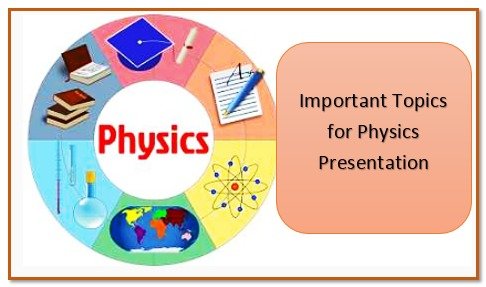Important topics for physics presentation
Important topics for physics presentation

Important topics for a physics presentation
1. FUTURE ENERGY SOURCE:
Nuclear, solar, wind and biofuels are just some of the promising alternatives for a cleaner and greener future. Other relatively new energy sources are also being researched, such as fuel cells, geothermal energy and ocean energy.
2. DARK MATTER AND DARK ENERGY:
Because dark matter is made up of particles that neither absorb nor reflect light nor emit it, it is impossible to identify it by electromagnetic radiation monitoring. An improbable type of power that generates a force that defies gravity and is thought to be the reason for the universe's fast expansion.
3. HYDROELECTRIC:
Hydroelectricity, electricity generated by turbine-driven generators that convert the potential energy of rapidly falling or flowing water into mechanical energy.
4. FIBER OPTIC COMMUNICATIONS:
To transmit data from one point to another, fibre-optic communications require pulses of infrared rays. The light creates an electromagnetic carrier wave that is modified to transmit data.
5. SATELLITE:
A satellite is an object that orbits around a planet or star. For example, the earth is a satellite because it revolves around the sun... Usually the word "satellite" means a machine that is launched into space and moves around the earth or some other body in space. The Earth and the Moon are examples of natural satellites.
6. WIRELESS ELECTRICITY:
Wireless power transmission, wireless power transmission, wireless power transmission or electromagnetic energy transfer is the wireless transmission of electrical energy as a physical connection.
7.LASERS:
A laser is a device that emits light through an optical amplification process based on the stimulated emission of electromagnetic radiation. The term "laser" is acronym for "light amplification by stimulated emission".
8. SENSORS:
A sensor is a device, module, machine or subsystem that has the purpose of detecting events or changes in the environment and sending the information to another electronic device, often a computer processor. The sensor is used with other electronic devices.
9. THE BIG BANG THEORY:
The big bang theory provides a cosmic model of the universe as observed from the first period that is believed to have existed to later large-scale evolution.
10. MOTION OF PLANETS AND GRAVITY:
Newton's principles of gravity and rotation provided an explanation for Earth's yearly orbit around the sun. The earth will move through the universe, but the sun exerts a constant gravitational pull on our planet. This force bends the path from Earth to the Sun, pulling the planet into an elliptical shape.
11. KEPLER'S LAW:
Three propositions describe orbital motion. The planets orbit around the sun in an elliptic fashion, according to the first law. The second states that the planet's radius vector wipes out equal areas in equal times. The third law relates the distances of the planets from the sun to their periods of revolution.
12. ARTIFICIAL INTELLIGENCE:
In computer science, artificial intelligence, also known as machine intelligence, is the intelligence of machines, as opposed to the natural intelligence of humans and animals.
13. DOPPLER EFFECT IN SOUND AND LIGHT:
When wave energy, such as sound or radio waves, comes from two objects, the wavelength may appear to have changed as one or both objects move. This is called the Doppler effect.
14. QUANTUM MECHANICS:
A branch of mechanics concerned with the mathematical description of the motion and interaction of subatomic particles, including the concepts of energy quantization, wave–particle duality, the uncertainty principle, and the correspondence principle.
15. EINSTEIN'S RELATIVITY THEORY:
General relativity, sometimes known as "general relativity, is a geometric theory of gravity that was presented by Albert Einstein in 1915 and serves as the basis for the way that gravity is currently described in modern physics.
16. PHOTOELECTRIC EFFECT:
The emission of electrons or other free carriers when electromagnetic radiation, such as light, contacts a substance is known as the photoelectric effect.
17. STRING THEORY:
A theoretical framework known as string theory substitutes one-dimensional objects known as strings for the point particles of particle physics. It details the motion and interaction of these threads as they move through space.
18. TOUCH SCREEN:
The touch screen is an electronic visual display that the user operates by touching the top of the screen with their fingers.
19. PARTICLE PHYSICS:
the study of the fundamental building blocks of the universe, including subatomic particles such as quarks, leptons, and bosons, and the Standard Model of particle physics.
20. COSMOLOGY:
The study of the origin and evolution of the universe, including the big bang theory, cosmic microwave background radiation, dark matter, and dark energy.
21. BLACK HOLES:
Unraveling the mysteries of these mysterious cosmic objects, discussing their formation, properties, event horizons and the Hawking radiation phenomenon.
22. QUANTUM COMPUTING:
The study of the principles and potential applications of quantum computing, including qubits, quantum algorithms, and the concept of quantum supremacy.
23. NANOTECHNOLOGY:
exploring the world of nanophysics, discussing applications in materials science, electronics, medicine and energy, as well as future challenges and prospects.
24. RENEWABLE ENERGY:
An analysis of different renewable energy sources such as solar, wind, hydro and geothermal energy, discussing their physical mechanisms and their role in mitigating climate change.
25. OPTICS AND PHOTONICS:
The study of the behavior and properties of light, including topics such as reflection, refraction, diffraction, interference, polarization, and applications in telecommunications and imaging.
26. FLUID DYNAMICS:
Fluids dynamic provides understanding the behavior of fluids and gases, discussing concepts such as Bernoulli's principle, turbulence, boundary layers and their application to aerodynamics and hydrodynamics.
What's Your Reaction?





















